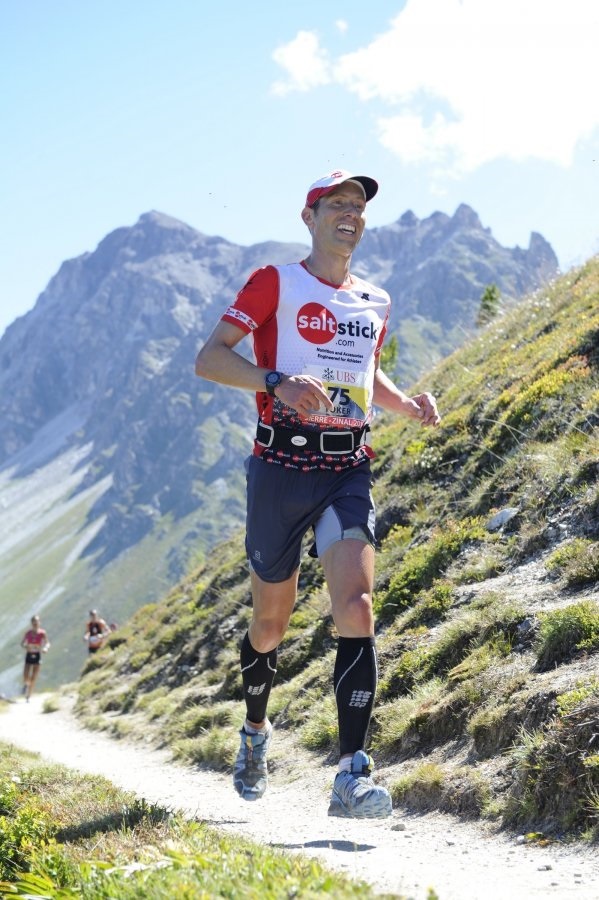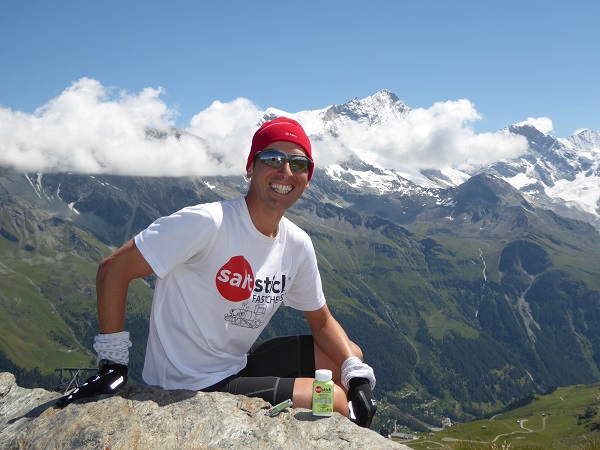
This week’s blog post is a slight change of pace from our usual content. Written by our CEO, Jonathan Toker, Ph.D., it tells the story of how SaltStick can be used for trail running success. Jonathan recently completed the Glacier3000 and Sierre-Zinal, two tough trail-running events in Switzerland, and his blog post details the “quad-busting ascents” and “stones and rocks that threaten twisted ankles with every step” he encountered in Europe. We hope you enjoy the fun read!
Gstaad and Zinal, Switzerland August 2016
Jonathan Toker, SaltStick Founder
Landing in Zurich, it was difficult to determine from the Southern horizon where the cloudy sky ended and the snow-capped peaks began. The 9-hour time zone difference from the US West coast was catching up, but sleep needed to wait until after a few hour train journey into those same 3-4000m peaks.
Arriving at the Gstaad train station amidst a slight downpour was not the welcome to sunny alpine meadows I was anticipating. But it was a welcome nevertheless to Swiss hospitality and the start of a running adventure. Gstaad is the winter alpine home to royalty, the rich and famous, and others taking in the slopes and glaciers. But summer brings out an entirely different adventure set, those seemingly more interested in seeing cows to pasture, hiking trails, and endurance junkies like myself seeking a dizzying alpine trail network. And trail racing.
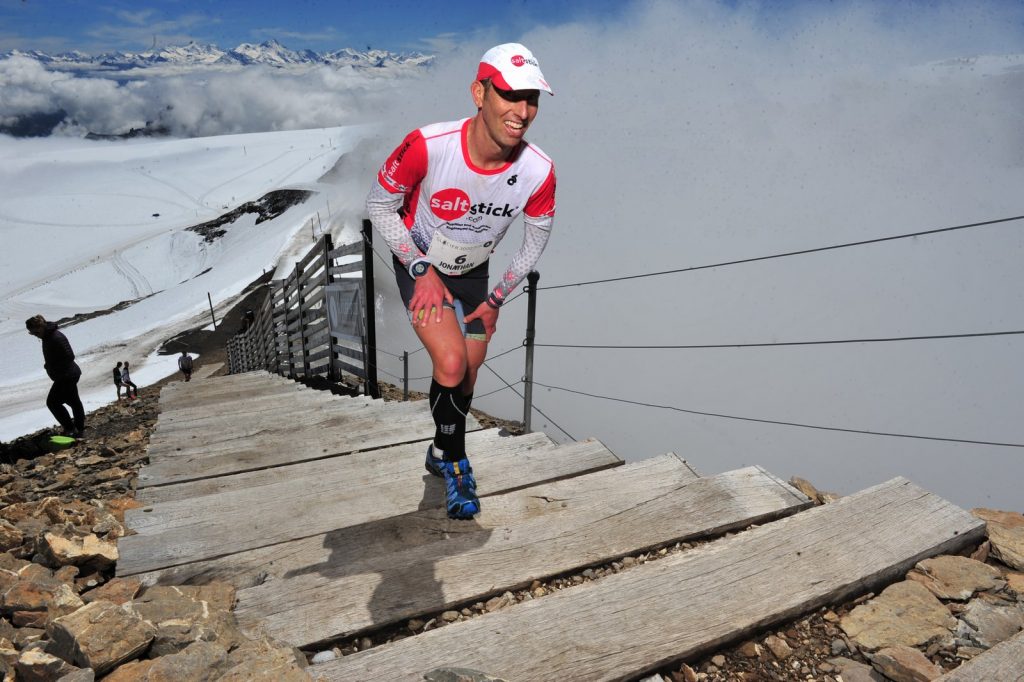
The Glacier3000 trail run (glacier3000run.ch) began a nine years ago, and has become the “to-do” summer event in the Gstaad area. At 26km, it appears to be little more than a simple extended half marathon. But once glance at the elevation profile is a reminder of a hockey stick, the kind of revenue curve that makes a VC firm salivate. Only in this instance, the reward is a view from atop a glacier at 3000msl. Net gain is 2000m. Net loss is 200m. I didn’t see any downhill. In what has become a hallmark of most Swiss races, organization was carefully orchestrated and runner details were considered, though sometimes with a view more to efficiency than to comfort.
Other than the topographic profile, the other defining novelty of the Glacier3000 is the last 2km section. After a quad-busting ascent on single track, the route delivers runners to the melting base of the Scex Rouge glacier. Tourist infrastructure includes a chairlift and alpine sled run, but look the other way, and it’s a vast empty snowy meadow surrounded by craggy snowy peaks. This isn’t a grassy meadow but rather snow as the top layer of deep glacial ice. A groomed “snow path” directed runners, then ankle-deep in wet snow, through the plateau for a kilometer, and then on and upwards to the last climb, a steep muddy path and terminal staircase to the finish line. After a celebratory walk across the alpine viewing bridge, the run included a welcome gondola descent to the valley floor and bus ride back to Gstaad.
Personal nutrition for this 26km event consisted of taking 2 SaltStick Caps prior to the event, and consuming approximately 1.5L of water and 3 capsules and 6 Fastchews (approximate total of 900 mg sodium) during the event, along with approximately 500 kcal of maltodextrin-based energy.
I would be remiss if I didn’t mention the nearby and exhilarating Via Ferrata La Videmanette with routes of three difficulties to choose from, easy accessible from the top of the eponymous gondola. These “ways of steel” allow climbers and non-climbers to experience thrilling heights and technical rock climbing while benefiting from uninterrupted fixed rope protection and metal rebar steps. Also, Gstaad has a world-class music festival, sports facility with indoor lap pool, and nearly endless miles of marked hiking and running trails. For those inclined, private jets can land at nearby Saanan airport.
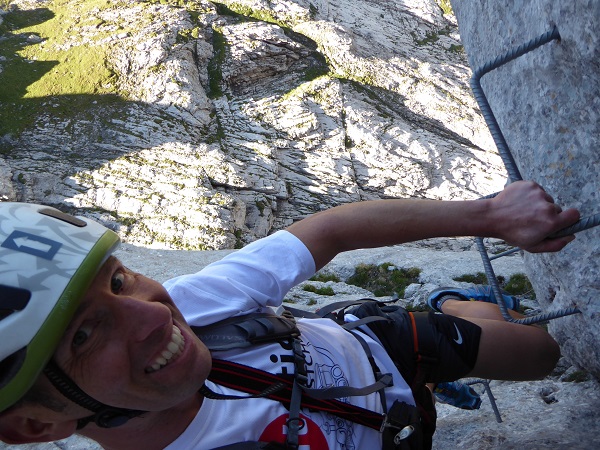
“Travel is fatal to prejudice, bigotry, and narrow-mindedness, and many of our people need it sorely on these accounts. Broad, wholesome, charitable views of men and things cannot be acquired by vegetating in one little corner of the earth all one’s lifetime.” Mark Twain.
Perhaps Mr. Twain was thinking of Switzerland. In the deep southwest corner of this land-locked nation is the Valais canton that straddles between the French and German sections and borders France. Historically very distinct, this town of Sierre sits close to the geographical middle of the Rhone valley, itself bounded on the west by Lake Leman and the town of Montreux, and on the east by the towns of Visp and Brig, and onward to Andermatt. To the south extends the Anniviers valley that ends with the hamlet of Zinal. Between the two towns lies a mountainous double-lane road, 1000 meters of elevation, and a 31km trail run that is considered as one of the toughest and most competitive in the region.
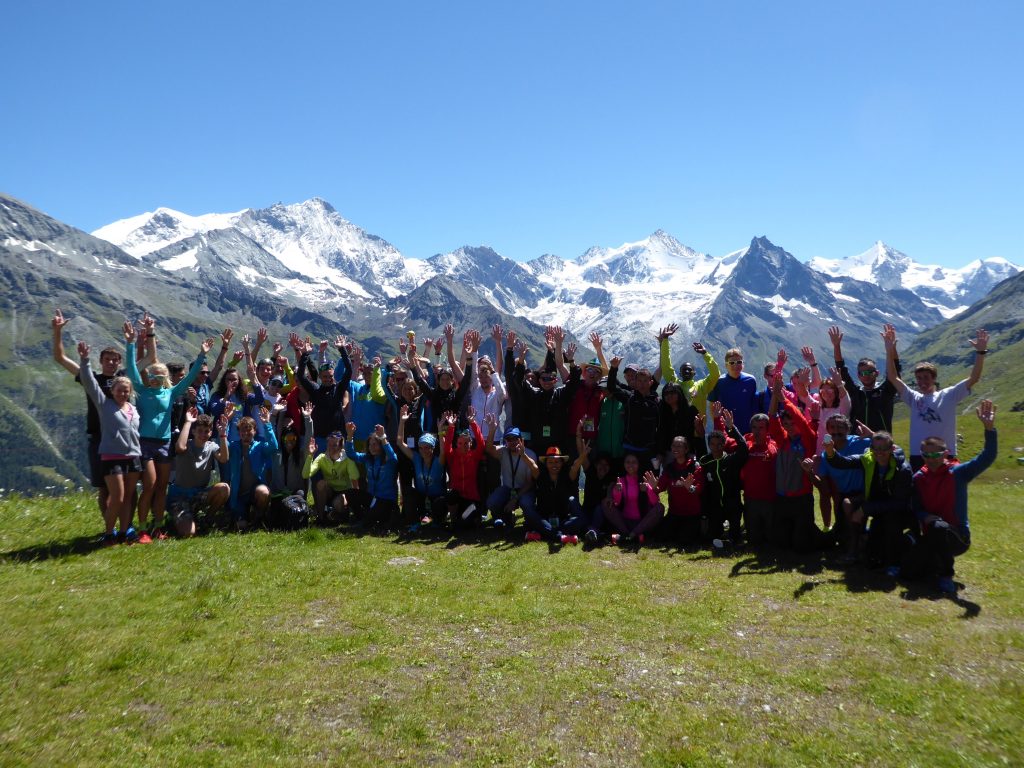
The Sierre-Zinal (www.sierre-zinal.com) event began in 1974 and with a route that has little changed over time, has seen ostensibly all the top trail runners over those four decades grace its trails. If there is any doubt as to its difficulty, the first 10km features a net climb of about 1300m, some of it so steep that running is futile. The last 10km is mostly downhill with technical stretches over stones and rocks that threaten twisted ankles with every step. Aid stations were well stocked though a bit infrequent for the hot race day. Pre-race, the few portable toilets that had been used by the walking group who had started four hours earlier, were out of paper.
Personal nutrition for this 31km event consisted of taking 2 SaltStick Caps prior to the event, and consuming approximately 2L of water and 4 capsules and 6 Fastchews (approximate total of 1100 mg sodium) during the event, along with approximately 500 kcal of maltodextrin-based energy.
One of the most compelling aspects of international racing is meeting other athletes from around the globe. Sierre-Zinal is like the United Nations of trail running. Invited and elite athletes from over 15 countries (see photo) filled the cafeteria, speaking in United Nations of languages. English was a common denominator, though French, Spanish and German were used extensively. Interestingly, unlike many native English speakers, most of these athletes were multilingual. It was with longing and regret that I took leave of this merry scene on the last day of my voyage, and wearily took the train back to Zurich, wending my way home, but with newfound friends (Facebook accounts and all) and new destinations in mind in the nearby Dolomites and the Austrian Alps.
The Swiss Alps and hospitality beacon again, with unconquered courses and PRs to break at Glacier 3000 and Sierre-Zinal.
Jonathan Toker, Ph.D. – Jonathan is an elite-level runner and triathlete who hails from Canada and lives in Southern California. He received a Ph.D. in organic chemistry from The Scripps Research Institute in 2001, and raced in the professional ranks as a triathlete and runner for 5 years. A 9-time Ironman finisher, with a personal best of 9:13. Dr. Toker worked as a scientist in the biotech industry for 5 years prior to launching his unique SaltStick Electrolyte and Dispenser lineup in 2006.
